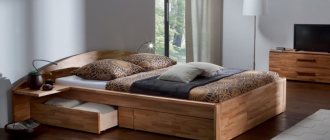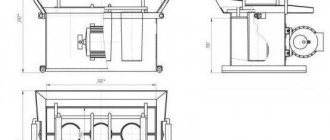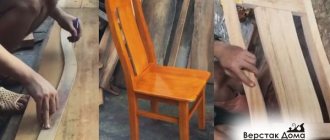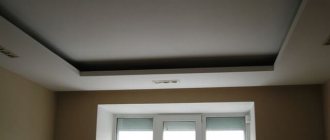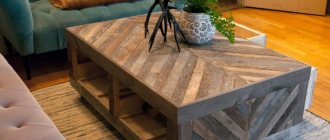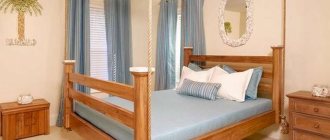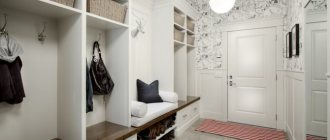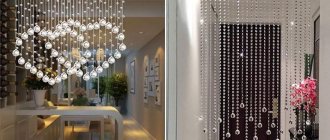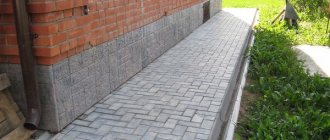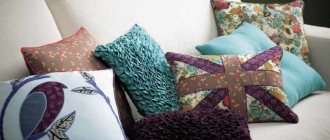One day I realized that in my house there was not enough one more bed on which I could accommodate a relative who came to stay or a friend who stayed up late. Instead of buying new furniture, I decided to make my own.
In this article: [Hide]
- Necessary tools, materials and bed design
- Assembling a single bed
Benefits and savings
- Firstly,
you can make the size you need for yourself. Of course, it will depend on the size of the mattress, but you will know for sure that for a certain mattress you will have the desired design of the bed itself, which is not so easy to find in ready-made furniture stores. - Secondly,
the development process itself is so interesting and exciting that this activity may well become your hobby. This only at first and without the correct information seems like a difficult and confusing task; in fact, the work of creating, designing and assembling a bed and other furniture with your own hands is no harder than a children’s construction set, only the “spare parts” are a little different. - And thirdly,
of course, is the price. Even, or rather, your earnings, which on average will be about 100%. Yes, that’s exactly how much you can earn if you decide not to buy a bed, but to make it yourself. You would pay extra exactly 100% of the cost if you decided to buy a bed in a store or make it to order.
So that everything works out perfectly for you, in this article we will analyze in detail the entire process of developing and making a bed with your own hands, as well as provide all the necessary diagrams and drawings for its manufacture.
General characteristics and dimensions of the bed
Using these instructions, we will make an inexpensive single bed from chipboard for a teenager, measuring 180 x 1900 x 900 mm (height x length x width). According to its location, it will be placed in a corner, so the bed will be considered a corner bed, this is how it is shown in the photo below:
This is a photo of the project. It’s a shame, but we didn’t have time to take real photos of the “living” bed.
We made this piece of furniture entirely from chipboard. Visible parts - such as the headboard, footboard and sides - were made of laminated chipboard, and the internal, invisible parts were made of rough. This was done to reduce the cost of the design itself, the cost of which was only $75.
No slats were used here. As a base for the mattress, a rough chipboard board was used, which lay on the “sides” screwed to the sidewalls, as well as on the inner legs.
What material can a bed frame be made from?
The bed frame can be made of wood, metal, MDF, chipboard or rattan. Wood is still the most popular. This is due to its high technical and operational characteristics. The material is durable, environmentally friendly and durable. Wooden products have a presentable and luxurious appearance.
Elite expensive products are made of mahogany or teak wood. More affordable beds are made from solid beech, oak, ash, pine, cherry, alder or birch. The specific type of wood determines the cost of the structure. A bed made of logs looks unusual and original.
A metal bed is not only durable and wear-resistant, but can also become a bedroom decoration
Chipboard or MDF are also often used to make beds. This is due to the affordable cost of the material compared to the price of solid wood. Pressed wood slabs are distinguished by a rich color palette. The surface can be plain or imitating wood shades. The disadvantage of the material is some toxicity, which occurs due to the presence of formaldehyde in the composition of the products. There are also options for plywood beds, characterized by strength and durability.
Metal beds have firmly established themselves in modern interiors. The material is characterized by high strength, wear resistance and durability. Metal structures are made with gilding or silver, imitate the appearance of an aged product, and can be covered with leather or fabric. Such designs fit perfectly into rooms decorated in country, modern or high-tech styles.
Detailing and drawing
As mentioned above, chipboard was used as the material for making the bed.
You can download a drawing of the bed and a list of parts with dimensions in the archive at the end of the article.
To order the necessary parts, you just need to contact any company that sells and saws chipboard, as well as edges and milling on CNC machines.
The headboard of our design and its large side panel are cut using a CNC router. The archive contains drawings of these parts on a scale of 1:1. All you need is to give this drawing to the contractor and they will mill out the necessary parts for you.
What is laminated chipboard and what is the difference from MDF?
MDF , medium-density fiberboard, is produced by pressing small wood fibers. Natural lignin and synthetic compounds (in small quantities) are used as binding components.
MDF
Chipboard is produced by hot pressing of wood processing waste with the introduction of thermosetting adhesive resins. The result is a material that is sufficiently resistant to temperature changes, has a homogeneous structure, is easy to process and durable, which is actively used in furniture production. Requirements for slabs are regulated by GOST 10632*2014. The big advantage of chipboard over MDF is its low cost.
Chipboard
However, there are also disadvantages that need to be warned about.
- the material is not intended for fine processing;
- the slightly loose structure does not allow re-installation of the fasteners (when the screw is turned out, the material begins to crumble and for the next installation of the hardware it is necessary to either make a hole of a larger diameter or drill at another point);
- The biggest problem is the use of phenol-formaldehyde resins in production, which leads to the release of harmful substances (if the permissible concentration is exceeded) for health.
In accordance with GOST, the scope of application of chipboards with various indicators of formaldehyde emission is limited.
Scope of application of chipboards at various levels of formaldehyde emission
By the way, in many countries the production of chipboards with emission class E2 is prohibited. You can find out the exact characteristics of the material only by reading the quality certificates, which not everyone does. A clear sign of the presence of harmful impurities in the material is a strong odor.
In connection with the above, despite the fact that the standard allows the use of certain types of slabs for the manufacture of children's furniture, this is not recommended. Children's health is more valuable.
Laminated chipboards are obtained after applying a decorative coating to chipboards (lamination or lamination). As a result, furniture makers have at their disposal an inexpensive but excellent-looking material, which has also received additional strength qualities and resistance to external influences.
laminated chipboard
Important! Laminated chipboard may have additional properties: increased moisture resistance or fire resistance, which is achieved by using special impregnations.
Types of laminated chipboard
The classification of laminated particle boards is carried out in different ways. However, the following division by type is most often used.
Table. The most commonly used types of chipboard.
| Marking | Distinctive characteristics |
| B.S. | The material is mainly used for the production of office furniture |
| S.E. | The surface resembles the texture of wood with pores |
| S.M. | Smooth surface slabs |
| MAT | Boards laminated with matte film |
| PR | Material with a porous structure |
| P.E. | The laminated surface has an orange peel texture |
In furniture production, BS or PR boards are mainly used (for the production of tables, beds or cabinets) or SM, ideal for the production of partitions.
There are several types of chipboard
In addition, the choice of material is made depending on the thickness and color required for the manufacture of structures. Sheets are produced in thicknesses from 0.8 to 3.8 cm, the most common values being 1, 1.6, 1.8, 2.2, 2.5 and 2.8 cm. For furniture production, boards with a thickness of from 1.6 to 2.2 cm. The larger this figure, the more significant loads the chipboard can withstand. Accordingly, the price of products increases.
Instructions for assembling a single bed with your own hands
So, we have all the necessary parts, we can start assembling. In fact, the design of the bed is incredibly simple, so it is assembled in just a few steps.
Necessary tool
- Screwdriver with a bit for confirmations,
- PZ bit for self-tapping screws,
- Confirm drill,
- Awl,
- Pencil and ruler
- A cutter for hinges (I’ll explain why later).
First, you need to install plastic bearings on the sidewalls. In general, they come in different types:
- in the form of a button,
- under the nail,
- with leg, etc.
Despite their simplicity, they perform an important function - they protect the end of the chipboard from moisture that can accumulate on the floor during cleaning.
I used plastic bearings with screws. We screw them to the lower end of the side panel with ordinary 3.5 x 16 mm screws.
Next up is a pull-out bed
Now it's time to make the bed. The front rounded edge and the bed frame itself should be cut from 19 mm chipboard. The bottom sides and cover must have sufficient rigidity and strength to support the weight of several people. For this reason, it is better to cut the elements of the lid and side wall from a 22 mm shield. Cut out all elements according to the prepared drawing. So, here is the sequence of making a pull-out bed:
- The bed is marked on the board and MDF panel. You will need to cut out the following elements from the slab: the lower base of the bed, which will be rounded at the front. To do this, use an electric jigsaw. The cover for the podium can be cut from a furniture panel. It is recommended to clean each cut so as not to drive in a splinter.
- To strengthen the flooring, cut out the sides from the board. According to the markings, these sides are attached to the floor of the podium. Next, glue stiffening ribs from 40x60 mm timber to the edges of the flooring. The board will have a height of 430 mm. Bed wall 130 mm. Mattress height 200 mm. As a result, the height of the bed structure with mattress will be 330 mm. To avoid any difficulties when rolling out the bed, the side of the flooring can be additionally reinforced with stiffening ribs: crosswise or longitudinally.
- The glue should dry well. After this, cover the sides with a layer of varnish and only then install the structure on the legs.
- It will be necessary to select grooves under the supporting beam. They will act as a support for the triangular niche cover.
- At this stage, the slatted mattress frame is assembled. Screw the chipboard strips to the slatted base. From two scraps of slab, assemble a semicircular façade. Each of the segments should be secured with screws. Between the bed frame and the rounded front of the bed, insert a stop, which is cut from the remains of MDF.
- Now all that remains is to screw the furniture casters to the lower base of the lying area. And attach the timber parts to the front lower part of the bed. The bed is ready!
Retractable design drawing
Finally, cut out the extension step and secure it with screws. Triangular covers should also be cut for corner niches. Once all this is done, you can check the functionality of the bed by rolling it out. If everything is working properly, you can continue working.
Screw the side ends of the decking to the beam of the wall frame. Glue the support rail into the finished grooves, which is necessary for laying the triangular cover. This entire structure is additionally secured with screws.
At the end, the ladder is installed and the work is completed.
